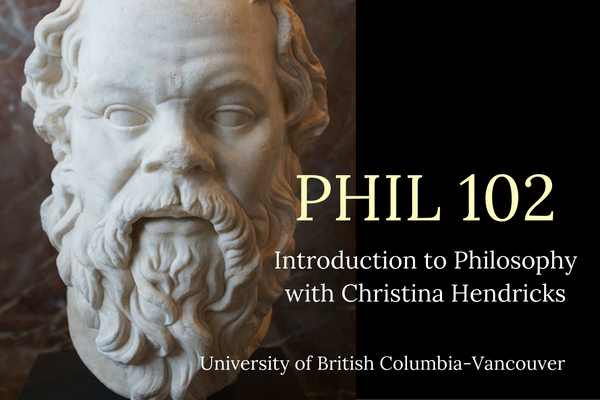While I was on sabbatical in 2012-2013, I participated in numerous open, online courses, and had very positive experiences with things like synchronous webinars, asynchronous communications on blog posts and discussion boards, and the like. Then when I got back and started teaching in my usual way, I found myself wondering: why am I spending most of the class sessions giving a lecture that I could just as well have recorded and placed online? What value added is there to having me in the room if all I’m doing is lecturing? Of course, I also do other in-class activities, Q&A, etc., but I wondered if I could send more time doing those things if some of the lecture were moved out of the classroom. That’s my general motivation for being here, to explore what options there are for doing some of the class content online and some F2F, and what makes most sense to do when we’re all in a room together, to make the most of that time.
I have asked to teach a section of Introduction to Philosophy in the Summer of 2015 in order to give me time this year to plan it as a flexible learning/blended learning course. This also means it will have fewer students than the usual 100-150 or so, and when I’m doing something quite new to me like this I find it helpful to start a bit smaller when possible!
General info about the course
Introduction to Philosophy is a first-year course that does not have any prerequisites or assume any prior knowledge of philosophy. This course is not required for majors, and the department doesn’t have strict rules as to what must be included; however, there are three “types” of this course and each one has a particular focus. PHIL 101, Intro to Philosophy I (one term long) is meant to introduce students to metaphysics and epistemology in some way; PHIL 102, Intro to Philosophy II (one term) is meant to introduce students to value theory (e.g., ethics, social and political philosophy, and/or aesthetics). Students can take both of these courses, in any order, or just one of them (or none, as they are not required for anyone). Alternatively, they could take a year-long course, PHIL 100, that covers all of those areas in one course. My understanding of these courses is that they are meant to give interested students a taste of what philosophy is all about, and to engage them as much as possible so they might consider taking more philosophy courses (or not…at least having some exposure is good!).
I teach the 102 course, the one focused on value theory. I have taught it in several ways in the past:
- As a historical overview of majory figures in Western Philosophy in the areas of ethics, social/political philosophy, and aesthetics
- As a kind of introduction to ethics and moral theory (but this meant it overlapped too much with our second-year moral theory course)
- As a “philosophy of happiness” course–what have philosophers said about happiness?
- Most recently, I created the course around the theme: what is philosophy, what do philosophers do, and what is the value of any of this? What have philosophers themselves said about this? What have philosophers used their philosophical work to DO? I think this version worked the best out of all of them.
Here is a link to my most recent course website. Students were also blogging on this site, but I took the students’ blogs off the site after the course was finished, because I didn’t ask their permission to keep them up there!
Basic structure, enrollment, TA’s, assessments
This course is usually 3 hrs per week: 2 hrs of lecture, 1 hr of discussion section (groups of 25 students per section, usually led by TAs). In the past, I’ve used those two hours of “lecture” time to both lecture and engage students in in-class activities like small group discussions, writing answers to questions on a group document such as in google docs, engaging in debates, and more. I plan to use a tool like Poll Everywhere or Learning Catalytics to make my lectures more interactive, to have students give answers to questions, etc. I am not planning to use Clickers because I’m not sure I’m going to be using them enough in my course to justify the expense to students.
When I have taught this course during the winter terms, enrollment has ranged between about 80-120 students, though sometimes it’s a bit more. In the Summer it will probably be around 45 students I think, maximum (unless I get a TA, in which case it will allow more). During the winter terms I usually have 2-3 TAs or so, running the discussion sections and marking some of the essays.
Much of the assessment for the course is based on essay writing, though some of the essays are quite short. I scaffold the essay assignments so they learn to write an essay in small steps. There is also a final exam which is partly essay questions.
How I’d like to make it into a blended learning course
I’m not quite sure yet, as I’m still in the early planning stages. I’m thinking it would be good to have more time in-class for things that really take advantage of us all being in a room together, which lecturing does not always do (unless it’s interspersed with interactive activities). So one idea is to put some of the lecture content online and ask them to read/watch videos before class, then use more of the class time for activities. What those activities will be I’m not entirely sure. And I have to be mindful not to just have this mean that students end up doing more work, having to take the time they would have spent in lecture in class and add it onto their out-of-class activities. I’ll have to cut down on some of the latter to avoid this problem.
I just met with an instructor who recently did a kind of flipped classroom approach, and he suggested that if students could use the class time to work on a larger project, such as a group project, that would help them see the in-class activities as beneficial. So the in-class activities could be small steps needed to work towards finishing a larger project, for example. I think that’s a good idea, though I’m not sure how I’d implement it in my course. It’s just something I’m thinking about.
That’s all I’ve got so far!
Currently
I think my current PHIL 102 course fits in between the face-to-face and the technology-enhanced sections. I’m talking about the “lecture” hours rather than the “discussion sections” once per week, which are different of course. I say in between those two sections of the diagram because while I’ve used some technology to enhance the in-class experience, I’d like to do more. Things I’ve done to use technology to enhance the lecture portions through more interactivity:
- Asked students to use a Twitter-like program at UBC that allows them to ask/answer questions synchronously during lectures (few did so, but that was a few years ago and maybe I’ll try again). I used “Pulse Press,” a theme on UBC Blogs to do this, since there may not be very many students who have Twitter accounts.
- Asked students to discuss questions in groups and post their answers to shared documents: sometimes on the UBC wiki, sometimes on Google Docs (so long as there are no names attached, due to FIPPA regulations)
Things I’d like to try in the next academic year:
- Use a tool like Poll Everywhere or Learning Catalytics to be like clickers (but I’m not ready to ask them to use Clickers yet b/c i’m not sure I’ll use them enough to justify their expense). These would be activities that are not attached to a mark for the students, since I wouldn’t be able to track participation and not everyone may have their own devices needed to participate.
- Some team-based learning sessions–maybe not a whole course made out of TBL sessions, but one or two in a course.
Aspirations
Where I would like my course to be by the end of the workshop: I’m hoping it’s closer to “Blended Active Learning” on the chart, though maybe I’ll just have started on the road to that by the time this course ends and will have to finish going down the road on my own. But that’s okay–there’s only so much you can do in three weeks! I am considering moving towards “Blended-reduced class time” because I want to avoid burdening students with extra work by moving some of the lecture material to outside class time. One way to do that is to reduce the face-to-face time. I would like to at least explore how one might do this, and whether a case can be made for it in my department. I don’t know what the bureaucratic hurdles might be for having a class meet less than 3 hours per week but count for 3 credits for a term.

